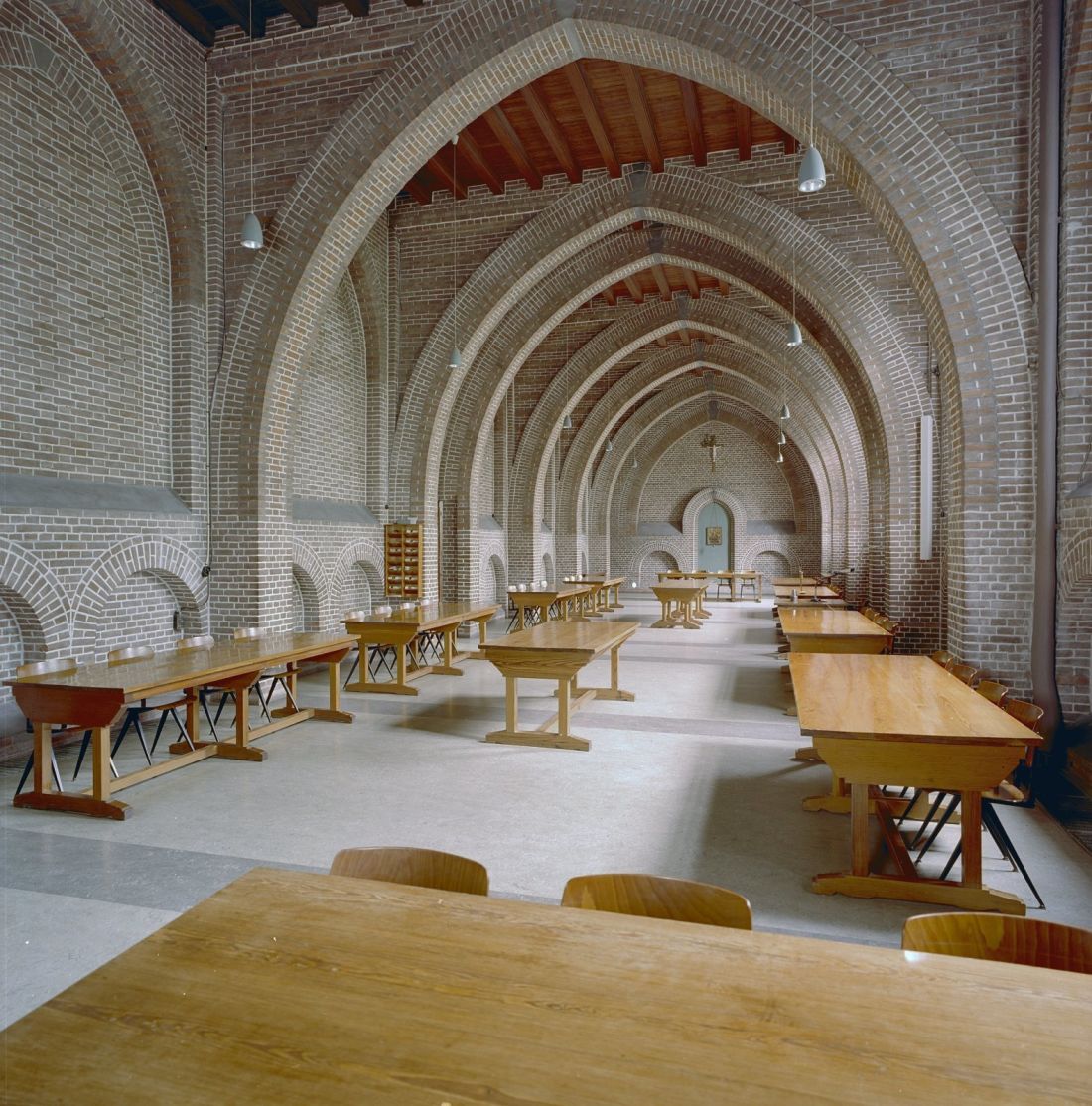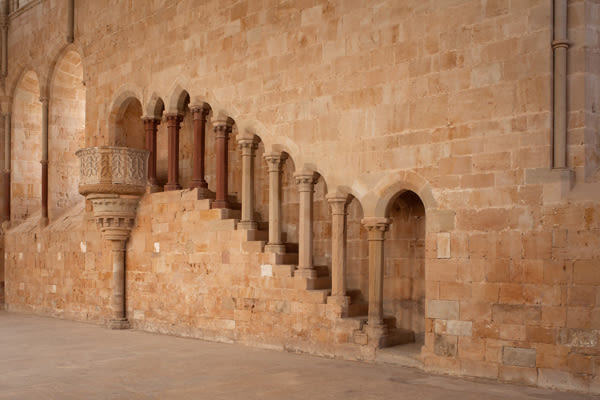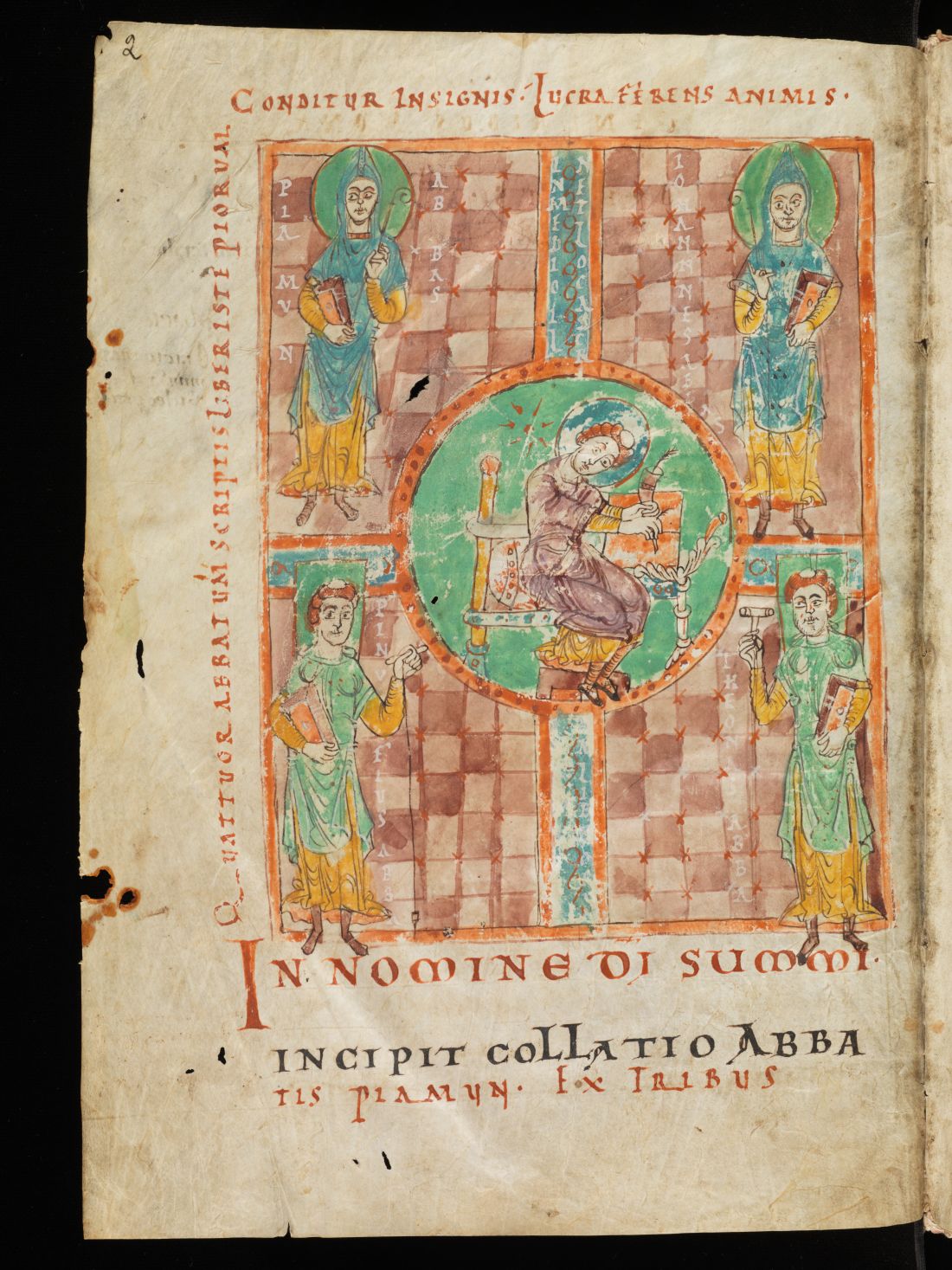cultură şi spiritualitate
Monastic mealtimes
Nourishment for body and soul

In most monastic orders, daily life was communal. Monks and nuns slept, prayed, worked, ate and read together with their brothers or sisters. At all times, their thoughts should have been oriented towards God and the tenets of Catholic faith – even during mealtimes. The Benedictine Rule contains strict guidelines on how meals had to be organised and what behaviour was (not) tolerated. Meals were served twice a day in the refectory, where the community sat at long tables, and talking was absolutely prohibited, even for the abbot or abbess. Communication, such as requesting food or cutlery, was done through hand signals.
The only member who was allowed to speak was the person appointed to read aloud during that week’s meals. The head of the community, usually the abbot or abbess, was allowed at times to give a short clarification of the text or to instruct the congregation on certain matters. The Rule of Benedict prescribes that good care be taken of the person appointed as reader. They were allowed a cup of diluted wine beforehand, so they would not have to carry out their duties on an empty stomach. Afterwards they were allowed to eat with the monks who were on kitchen service. In the refectory there often was a special place reserved for the reader and their books, such as a lectern or even a stone pulpit.

The Rule emphasises that the reader should be able to teach; that is to say, their reading and singing should be understandable to others. They were chosen not by rank or seniority, but by ability, and their service began after Mass on Sunday, when they would ask God’s blessing in the fulfilment of their duties by thrice singing the first words of Psalm 51: ‘Lord, open my lips and my mouth shall proclaim your praise’.
Below: A detail from a Cistercian Bible from Ten Duinen Abbey, showing the verse sung by new readers (column B, first line: D[omi]ne, labia mea ap[er]ies) (Bruges, Public Library, Ms. 2, f. 172r)
![A detail from a Cistercian Bible from Ten Duinen Abbey, showing the verse sung by new readers (column B, first line: D[omi]ne, labia mea ap[er]ies) (Bruges, Public Library, Ms. 2, f. 172r)](https://images.ctfassets.net/i01duvb6kq77/1SH1N5VrPB2y61fkKw3moC/b1b1183b21ee124683b95d14f01313d1/Cistercian-Bible-Ten-Duinen-Abbey.jpg?fm=jpg&fl=progressive&q=80&w=1100)
What was read aloud during meals? Unlike other parts of the day where reading was compulsory or encouraged, such as during Mass, the Offices, and self-study, Benedict did not prescribe the type of literature suitable for this occasion. From the twelfth century, fixed collections of texts were created that corresponded with liturgical dates, and biblical texts (and the medieval commentaries on them) were important. Lives of saints, or hagiographies, were also deemed particularly suitable, for they provided examples on how to live. In particular, the lives of the Church Fathers were popular. They were compiled by John Cassian, an important figure in early Christian monasticism.

On entering a monastery, one’s main purpose in life became ‘to love the Lord God with the whole heart, the whole soul and the whole strength’, according to the Rule of Benedict. Serving God meant praying and working, but also embodying the virtues of Christianity. Studying the Bible and other authoritative texts, memorising them word by word, and applying the lessons to one’s own improvement, was fundamental. Even during meals – an opportunity to nourish oneself physically after hours of praying, reading, writing or other kinds of labour – spiritual nourishment was also ensured.
This blog is part of the Art of Reading in the Middle Ages project which explores how medieval reading culture evolved and became a fundamental aspect of European culture.
STATISTICI
Numar de steaguri: 273
Record vizitatori: 8,782 (3.04.2011)
16,676 (3.04.2011)
Steaguri lipsa: 33
1 stat are peste 700,000 clickuri (Romania)
1 stat are peste 100.000 clickuri (USA)
1 stat are peste 50,000 clickuri (Moldova)
2 state au peste 20,000 clickuri (Italia, Germania)
4 state are peste 10.000 clickuri (Franta, Ungaria, Spania,, Marea Britanie,)
6 state au peste 5.000 clickuri (Olanda, Belgia, Canada, )
10 state au peste 1,000 clickuri (Polonia, Rusia, Australia, Irlanda, Israel, Grecia, Elvetia , Brazilia, Suedia, Austria)
50 state au peste 100 clickuri
20 state au un click

DE URMĂRIT
1.EDITURA HOFFMAN
https://www.editurahoffman.ro/
2. EDITURA ISTROS
https://www.muzeulbrailei.ro/editura-istros/
3.EDITURA UNIVERSITATII CUZA - IASI
https://www.editura.uaic.ro/produse/editura/ultimele-aparitii/1
4.ANTICARIAT UNU
https://www.anticariat-unu.ro/wishlist
5. PRINTRE CARTI
6. ANTICARIAT ALBERT
7. ANTICARIAT ODIN
8. TARGUL CARTII
9. ANTICARIAT PLUS
10. LIBRĂRIILE:NET
https://www.librariileonline.ro/carti/literatura--i1678?filtru=2-452
https://www.librarie.net/cautare-rezultate.php?&page=2&t=opere+fundamentale&sort=top
14. ANTICARIAT NOU
https://anticariatnou.wordpress.com/
15.OKAZII
https://www.okazii.ro/cart?step=0&tr_buyerid=6092150
16. ANTIKVARIUM.RO
17.ANTIKVARIUS.RO
18. ANTICARIAT URSU
https://anticariat-ursu.ro/index.php?route=common/home
19.EDITURA TEORA - UNIVERSITAS
20. EDITURA SPANDUGINO
21. FILATELIE
22 MAX
http://romanianstampnews.blogspot.com
23.LIBREX
https://www.librex.ro/search/editura+polirom/?q=editura+polirom
24. LIBMAG
https://www.libmag.ro/carti-la-preturi-sub-10-lei/filtre/edituri/polirom/
https://www.libris.ro/account/myWishlist
http://magiamuntelui.blogspot.com
27. RAZVAN CODRESCU
http://razvan-codrescu.blogspot.ro/
28.RADIO ARHIVE
https://www.facebook.com/RadioArhive/
29.IDEEA EUROPEANĂ
https://www.ideeaeuropeana.ro/colectie/opere-fundamentale/
30. SA NU UITAM
31. CERTITUDINEA
32. F.N.S.A
https://www.fnsa.ro/products/4546-dimitrie_cantemir_despre_numele_moldaviei.html
Evenimente
Anunturi
 Această retea este pusă la dispoziţie sub Licenţa Atribuire-Necomercial-FărăModificări 3.0 România Creativ
Această retea este pusă la dispoziţie sub Licenţa Atribuire-Necomercial-FărăModificări 3.0 România Creativ

Parteneri
Note
Hoffman - Jurnalul cărților esențiale
1. Radu Sorescu - Petre Tutea. Viata si opera
2. Zaharia Stancu - Jocul cu moartea
3. Mihail Sebastian - Orasul cu salcimi
4. Ioan Slavici - Inchisorile mele
5. Gib Mihaescu - Donna Alba
6. Liviu Rebreanu - Ion
7. Cella Serghi - Pinza de paianjen
8. Zaharia Stancu - Descult
9. Henriette Yvonne Stahl - Intre zi si noapte
10.Mihail Sebastian - De doua mii de ani
11. George Calinescu Cartea nuntii
12. Cella Serghi Pe firul de paianjen…
Creat de altmariusclassic Dec 23, 2020 at 11:45am. Actualizat ultima dată de altmariusclassic Ian 24, 2021.
Top Members
© 2024 Created by altmarius.
Oferit de
![]()
Embleme | Raportare eroare | Termeni de utilizare a serviciilor










Pentru a putea adăuga comentarii trebuie să fii membru al altmarius !
Alătură-te reţelei altmarius